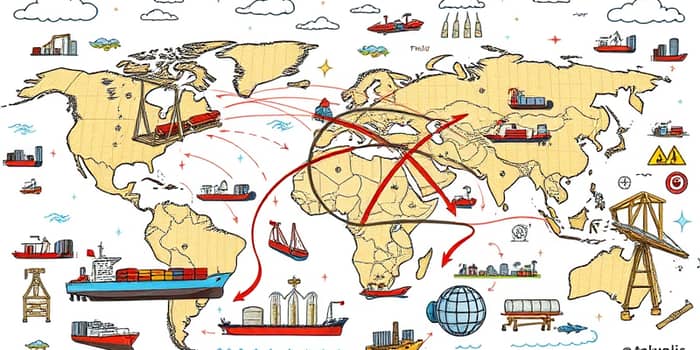
As 2025 unfolds, global commodity markets face unprecedented turbulence driven by a complex interplay of geopolitical tensions, shifting trade policies, and ongoing logistical bottlenecks. Stakeholders from producers to end consumers must navigate rapidly changing price landscapes with care and foresight.
During the first quarter of 2025, commodity prices experienced significant fluctuations, reflecting the impact of shifting trade policies and tariffs on supply and demand. While many benchmarks fell under pressure, pockets of strength emerged in key agricultural markets.
Analysts forecast an overall price decline of around 12% in 2025, followed by another 5% drop in 2026—the weakest stretch seen in over six years. Yet essential staples such as wheat, cattle and dairy have defied this trend, remaining elevated due to persistent supply constraints and demand in global markets.
Regional developments have also shaped outcomes: North American metals markets grapple with U.S. import duties, while European energy prices respond to shifting OPEC+ production and seasonal demand patterns.
These disruptions have had a dual effect: some commodity prices soared, while others tumbled under weakening consumption. Oil, for example, has declined to multi-year lows unseen since 2021 as OPEC+ plans to boost output by 411,000 barrels per day from May 2025. Conversely, copper briefly surged amid import investigations before dropping nearly $0.60 per pound in early April following intensified tariff threats.
Meanwhile, lumber prices climbed 7% year-to-date, driven by reduced Canadian exports and a temporary construction rebound, though further declines are expected as building activity slows.
To navigate this complex landscape, it helps to consider detailed projections and recent performance across major commodities. The table below summarizes expected price ranges, key supply chain drivers, and recent context:
Understanding these granular trends enables producers, traders and end users to anticipate cost pressures and adjust strategies accordingly.
Supply chain constraints translate into price changes through several key mechanisms. First, tariffs disrupt established sourcing by raising costs for importers and discouraging traditional trade flows. Second, intermittent supply shocks—from political unrest to extreme weather—create upstream bottlenecks that reduce available volumes. Third, the resulting heightened market volatility complicates planning, making budgeting and hedging more challenging. Finally, cost increases at one stage often ripple through subsequent sectors, amplifying inflationary pressures for end consumers.
Higher raw material costs ultimately reach households either through direct price increases for essentials or via reduced availability of finished goods. Lower-income families can be hit hardest when staples like dairy and meat become more expensive. On the production side, manufacturers must absorb or pass on rising input costs, squeezing profit margins and investment plans.
Practical strategies can alleviate some of these pressures:
To thrive amid uncertainty, companies and communities must adopt forward-looking approaches. Digital tools such as real-time tracking, predictive analytics and blockchain can enhance transparency across complex networks. Collaborative partnerships with diverse suppliers—ranging from small-scale farms to global mills—foster adaptability and shared investment in infrastructure improvements.
The outlook remains dominated by downside risks. A sharper global slowdown, renewed trade disputes or prolonged borrowing costs could further depress demand and amplify price swings. Yet, those who embrace adaptability will find opportunities to optimize operations and capture new markets.
By maintaining vigilant market monitoring, fostering transparent partnerships and pursuing strategic diversification of supply chains, stakeholders can turn potential disruptions into competitive advantages. This proactive mindset will not only protect profitability but also contribute to more resilient and equitable supply networks worldwide.
The last decade has tested the resilience of commodity markets through pandemics, geopolitical shocks and structural shifts. As 2025 advances, ongoing supply chain constraints will continue to shape price dynamics. However, by combining diligent analysis, flexible contracting and innovative technology, both producers and consumers can navigate this era of volatility more confidently.
With strategic foresight and collaborative spirit, the global community can transform challenges into catalysts for stronger, more agile supply chains—and a more stable tomorrow.
References













